Wat Chedi Luang, Chiang Mai
You can take it with you.
Wish you could have this information with you when you visit Chiang Mai? Now you can. Check out our ebook guides.
Wish you could have this information with you when you visit Chiang Mai? Now you can. Check out our ebook guides.
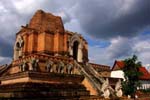 In its day, Wat Chedi Luang must have been the most impressive temple in Chiang Mai. Built about 600 years ago, the huge chedi
which gave the temple its name (the name of the temple translates to
"royal pagoda") must have soared high above the surrounding city. We
say "must have" because the chedi was mostly destroyed within a few hundred years of its construction. Some say it was an earthquake in the 17th century that did the deed; others say it was King Taksin's cannons firing on the city to chase out the Burmese in the 18th century.
In its day, Wat Chedi Luang must have been the most impressive temple in Chiang Mai. Built about 600 years ago, the huge chedi
which gave the temple its name (the name of the temple translates to
"royal pagoda") must have soared high above the surrounding city. We
say "must have" because the chedi was mostly destroyed within a few hundred years of its construction. Some say it was an earthquake in the 17th century that did the deed; others say it was King Taksin's cannons firing on the city to chase out the Burmese in the 18th century.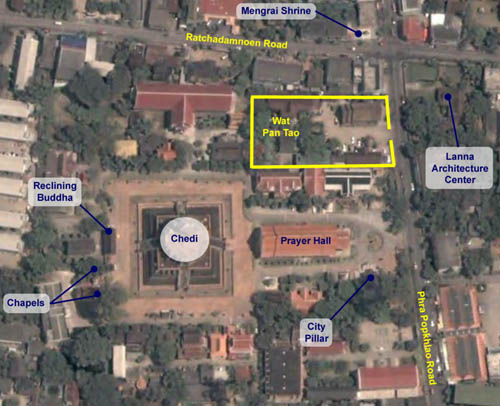
Plan of Wat Chedi Luang
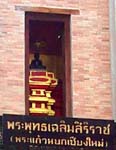 Reproduction of the Emerald Buddha in the Eastern niche of the chedi. |
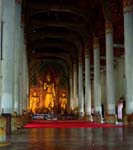 Altar in the main sala. |
Inside the main prayer hall, the altar is backed by a magnificent standing Buddha. Round whitewashed columns support an unfinished wood roof. However, the hall was in the middle of a "radical makeover" in August 2007, so the view may change soon.
Also inside the grounds of Wat Chedi Luang is the lak muang, the guardian spirit post (city pillar) of the city.
History
The construction of the temple started in the 14th century, when King Saen Muang Ma planned to bury the ashes of his father there. After 10 years of building time it was left unfinished, later to be continued after the death of the king by his widow. Probably due to stability problems it took until mid-15th century to be finished during the reign of king Tilokaraj. It was then 82 m high and had a base diameter of 54 m, at that time the largest building of all Lanna. In 1468, the Emerald Buddha was installed in the eastern niche. In 1545, the upper 30 m of the structure collapsed after an earthquake, and shortly thereafter, in 1551, the Emerald Buddha was moved to Luang Prabang.In the early 1990s the chedi was reconstructed, financed by UNESCO and the Japanese government. However the result is somewhat controversial, as some claim the new elements are in Central Thai style, not Lanna style. For the 600th anniversary of the chedi in 1995, a copy of the Emerald Buddha made from black jade was placed in the reconstructed eastern niche. The icon is named official Phra Phut Chaloem Sirirat, but is commonly known as Phra Yok.
Buildings
 Also on the temple grounds is the city pillar (Lak Mueang) of Chiang Mai, named Sao Inthakin. It was moved to this location in 1800 by King Chao Kawila; it was originally located in Wat Sadeu Muang. He also planted three dipterocarp tree there, which are supposed to assist the city pillar to protect the town.
Also on the temple grounds is the city pillar (Lak Mueang) of Chiang Mai, named Sao Inthakin. It was moved to this location in 1800 by King Chao Kawila; it was originally located in Wat Sadeu Muang. He also planted three dipterocarp tree there, which are supposed to assist the city pillar to protect the town.In a viharn near the entrance to the temple is the Buddha statue named Phra Chao Attarot (Eighteen-cubit buddha), which was cast in the late 14th century. On the other side of the chedi is another pavilion housing a reclining buddha statue.
Map
ดูแผนที่ขนาดใหญ่ขึ้น
Videos
Gallery
http://thailandforvisitors.com/north/chiangmai/cm-temps.html
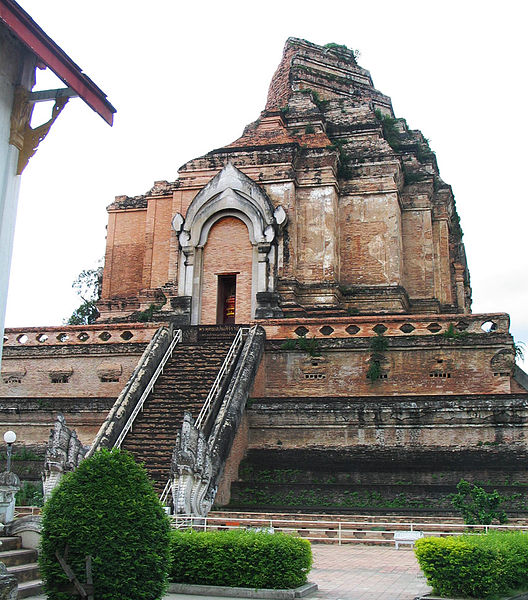

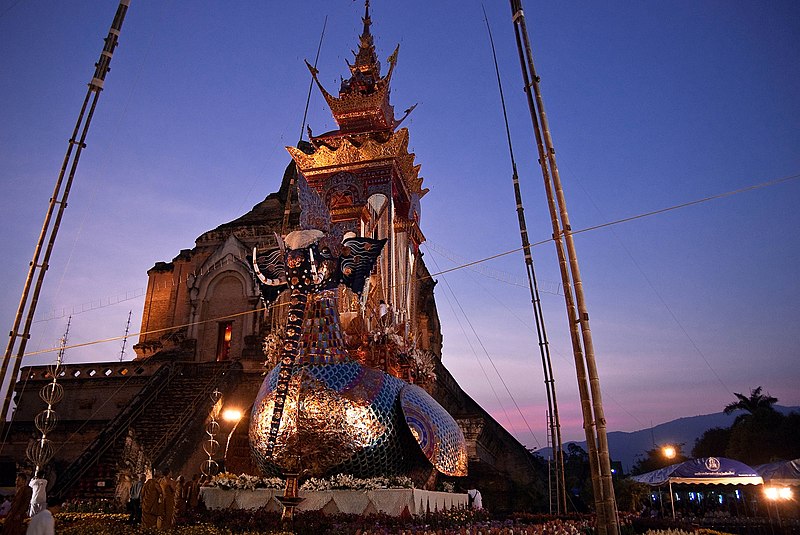

No comments:
Post a Comment